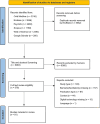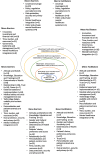Barriers and facilitators to the implementation of digital technologies in mental health systems: a qualitative systematic review to inform a policy framework
- PMID: 38408938
- PMCID: PMC10898174
- DOI: 10.1186/s12913-023-10536-1
Barriers and facilitators to the implementation of digital technologies in mental health systems: a qualitative systematic review to inform a policy framework
Abstract
Background: Despite the potential for improved population mental health and wellbeing, the integration of mental health digital interventions has been difficult to achieve. In this qualitative systematic review, we aimed to identify barriers and facilitators to the implementation of digital technologies in mental healthcare systems, and map these to an implementation framework to inform policy development.
Methods: We searched Medline, Embase, Scopus, PsycInfo, Web of Science, and Google Scholar for primary research articles published between January 2010 and 2022. Studies were considered eligible if they reported barriers and/or facilitators to the integration of any digital mental healthcare technologies. Data were extracted using EPPI-Reviewer Web and analysed thematically via inductive and deductive cycles.
Results: Of 12,525 references identified initially, 81 studies were included in the final analysis. Barriers and facilitators were grouped within an implementation (evidence-practice gap) framework across six domains, organised by four levels of mental healthcare systems. Broadly, implementation was hindered by the perception of digital technologies as impersonal tools that add additional burden of care onto both providers and patients, and change relational power asymmetries; an absence of resources; and regulatory complexities that impede access to universal coverage. Facilitators included person-cantered approaches that consider patients' intersectional features e.g., gender, class, disability, illness severity; evidence-based training for providers; collaboration among colleagues; appropriate investment in human and financial resources; and policy reforms that tackle universal access to digital health.
Conclusion: It is important to consider the complex and interrelated nature of barriers across different domains and levels of the mental health system. To facilitate the equitable, sustainable, and long-term digital transition of mental health systems, policymakers should consider a systemic approach to collaboration between public and private sectors to inform evidence-based planning and strengthen mental health systems.
Protocol registration: The protocol is registered on PROSPERO, CRD42021276838.
Keywords: Digital health technologies; Health reform; Health systems; Mental health.
© 2024. The Author(s).
Conflict of interest statement
The authors declare no competing interests.
Figures



Similar articles
-
Beyond the black stump: rapid reviews of health research issues affecting regional, rural and remote Australia.Med J Aust. 2020 Dec;213 Suppl 11:S3-S32.e1. doi: 10.5694/mja2.50881. Med J Aust. 2020. PMID: 33314144
-
Barriers and facilitators to the integration of digital technologies in mental health systems: A protocol for a qualitative systematic review.PLoS One. 2021 Nov 22;16(11):e0259995. doi: 10.1371/journal.pone.0259995. eCollection 2021. PLoS One. 2021. PMID: 34807937 Free PMC article.
-
Facilitators and Barriers to the Implementation of Digital Health Technologies in Hospital Settings in Lower- and Middle-Income Countries Since the Onset of the COVID-19 Pandemic: Scoping Review.J Med Internet Res. 2025 Mar 6;27:e63482. doi: 10.2196/63482. J Med Internet Res. 2025. PMID: 40053793 Free PMC article.
-
Barriers and facilitators to the integration of mental health services into primary health care: a systematic review.Syst Rev. 2018 Nov 28;7(1):211. doi: 10.1186/s13643-018-0882-7. Syst Rev. 2018. PMID: 30486900 Free PMC article.
-
Barriers and facilitators to implementing perinatal mental health care in health and social care settings: a systematic review.Lancet Psychiatry. 2021 Jun;8(6):521-534. doi: 10.1016/S2215-0366(20)30467-3. Epub 2021 Apr 7. Lancet Psychiatry. 2021. PMID: 33838118
Cited by
-
Digital transformation in healthcare: Have we gone off the rails?Asia Pac J Oncol Nurs. 2024 Apr 6;11(5):100481. doi: 10.1016/j.apjon.2024.100481. eCollection 2024 May. Asia Pac J Oncol Nurs. 2024. PMID: 38774536 Free PMC article. No abstract available.
-
Digitalization in the Emergency Department-An Interview Study of Nurses' Experiences in Norway.Nurs Rep. 2024 May 31;14(2):1414-1423. doi: 10.3390/nursrep14020106. Nurs Rep. 2024. PMID: 38921716 Free PMC article.
-
The Impact of Virtual Consultations on Quality of Care for Patients With Type 2 Diabetes: A Systematic Review and Meta-Analysis.J Diabetes Sci Technol. 2025 Feb 17:19322968251316585. doi: 10.1177/19322968251316585. Online ahead of print. J Diabetes Sci Technol. 2025. PMID: 39960237 Free PMC article. Review.
-
Barriers and Facilitators of Digital Mental Health Use in Regional, Rural, and Remote Australia: A Comparison of Clinician and Consumer Perspectives.Aust J Rural Health. 2025 Apr;33(2):e70011. doi: 10.1111/ajr.70011. Aust J Rural Health. 2025. PMID: 40130827 Free PMC article.
-
Updates on digital mental health interventions for children and young people: systematic overview of reviews.Eur Child Adolesc Psychiatry. 2025 Apr 25. doi: 10.1007/s00787-025-02722-9. Online ahead of print. Eur Child Adolesc Psychiatry. 2025. PMID: 40278894 Review.
References
Publication types
MeSH terms
LinkOut - more resources
Full Text Sources
Miscellaneous

